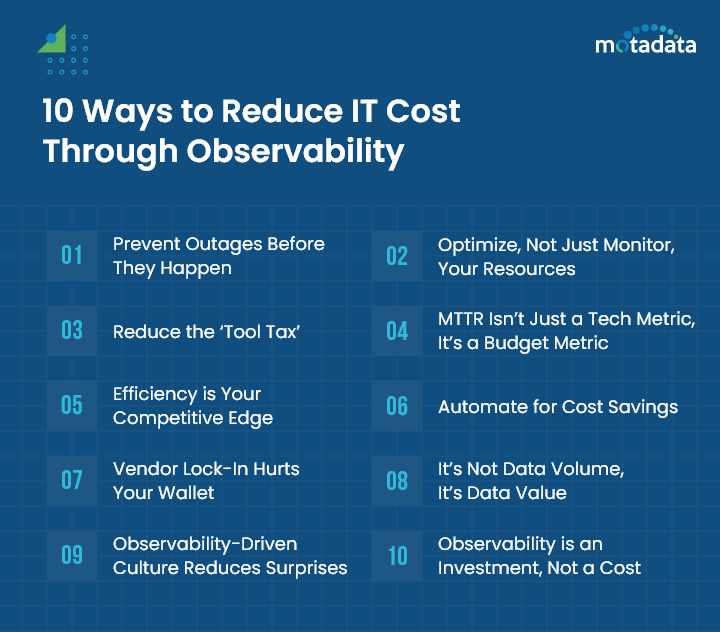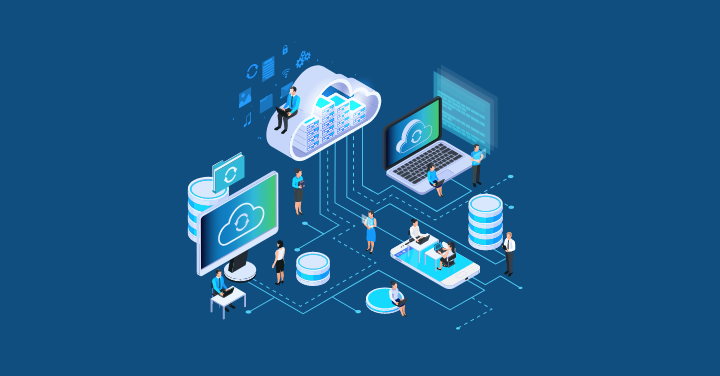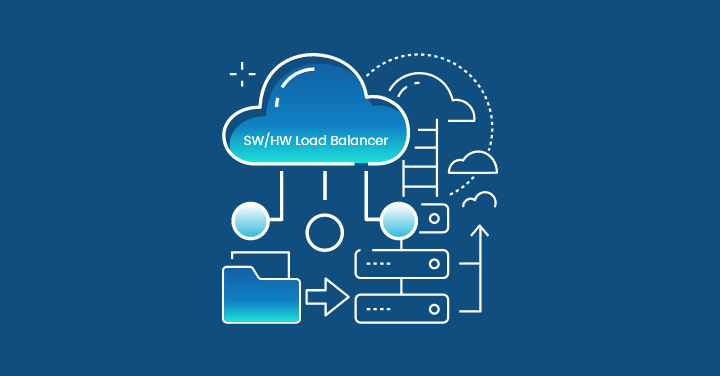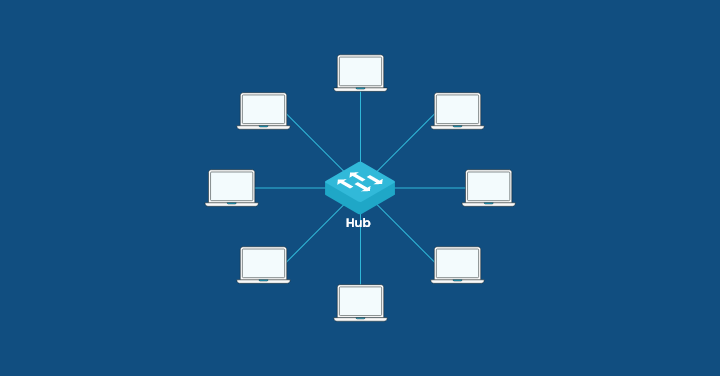Today, almost every other business is using cloud-native technologies and practices to grow business and increase revenue.
No doubt, the modern cloud computing approach offers several opportunities for businesses to grow but it is also creating a new set of challenges.
As per a report, SaaS companies spend almost 19% of their total revenue on IT. If not handled these challenges properly, it will erode the anticipated advantages. In fact, many businesses are under high pressure to reduce their IT costs.
It is true that cloud-native systems generate huge amounts of data on a daily basis, but with the right tools and practices, businesses can measure/track costs, implement optimization strategies, and effectively manage expenses for smooth business operations.
Observability is one of the best practices to maintain the performance and reliability of modern systems.
But achieving and maintaining observability can come at a steep price, sometimes in ways that are not immediately obvious.
In short, to save expenses, IT requires observability, yet observability solutions can be costly.
But, when used strategically, it can lead to significant savings in the long run.
With the help of observability solutions, IT Managers, tech teams, as well as executives can better monitor the internal state and behavior of each system by examining external outputs, log data, traces, and key performance indicators.
This strategy will further help them transform the way they handle cost control.
Let us dig deeper into the different ways that may help reduce IT cost through observability.
1. Prevent Outages Before They Happen
Nowadays, modern businesses are completely dependent on IT, as a result, even a minor interruption in service delivery can have an adverse effect on the company.
It is therefore crucial for businesses to prevent outages before they happen, not only to ensure smooth operations but also to protect revenue and reputation.
For example, due to downtime, customers won’t be able to visit your application and purchase products or avail services, resulting in them moving to your competitor’s platform and financial loss.
Further, it can damage your customer’s trust and eventually your reputation.
However, with observability, IT managers can avert such challenges and minimize the risk of service interruption.
Observability helps businesses monitor and analyze IT systems and data centers in real-time as well as sends proactive alerts for quick diagnosis and resolution.
It further aids in IT cost optimization, identifying the root cause of anomalies, unusual patterns, and trends.
With these insights, IT managers can address the issue at an initial stage and prevent outages/downtime from escalating into a major issue.
2. Optimize, Not Just Monitor, Your Resources
In order to maximize efficiency and minimize costs, it is essential for each business to work on its resources and cost management.
If your on-premises hardware is left underutilized or allocates more computing resources than necessary, chances are high that in the end, your business will have inefficient resources and a big list of unnecessary expenses.
This situation generally occurs when the business leaders, executives or team members lack visibility into the usage pattern or make decisions on conservative estimations.
By investing in observability monitoring, businesses can gain real-time insights into variable costs, resource usage and accordingly optimize them.
The tool will provide complete insights into memory consumption, PU utilization, network traffic, and other key metrics.
Based on this information, organizations can decide how to appropriately right size their infrastructure, improve business value, and reduce IT cost.
3. Reduce the ‘Tool Tax’
Tool tax refers to the costs associated with software licenses, and collaboration with teams that use various data sources, and tools used in IT operations.
At times, different departments use their own set of tools as per their need, resulting in multiple teams, in the same firm, using tools with similar functionalities.
Also, there are conditions where some businesses pay for software licenses but do not utilize them completely. All these situations contribute to increased costs.
However, with observability, businesses can perform centralized monitoring, identify redundant tools, and negotiate better licensing agreements. Thus, optimizing and reducing unnecessary expenses.
4. MTTR Isn’t Just a Tech Metric, It’s a Budget Metric
With the help of the MTTR metric, organizations can better assess how well the problem-solving procedures work in IT operations, especially after an incident or outage.
There are many individuals who view it as a technical metric, but in general, the IT budget of the organization is also greatly impacted by it.
Longer MTTRs may lead to greater incident resolution costs, lost productivity, and increased downtime.
The only solution to reducing these expenses is to use observability that helps make troubleshooting paths more transparent and enables IT staff to access relevant data more easily and in real time.
It means teams are able to quickly eliminate possibilities and concentrate on finding a fast solution, rather than wasting time attempting to identify the source of the problem.
5. Efficiency is Your Competitive Edge
Efficiency is essential for preserving a competitive edge and fostering corporate growth in the modern business environment.
If a business lacks efficiency in its transfers and processes, chances are high that it may notice delays in rolling out new features in the market or miss deadlines which may eventually lead to loss opportunities and financial implications.
Further, operational expenses are also increased by inefficient processes as to fix the issue you might require additional personnel and resources.
With observability, you gain visibility into the entire software development lifecycle, as a result, you can track the status of all processes and codes, identify potential issues at an initial stage, and streamline the deployment pipeline.
Complementing this with expert usability testing services ensures that the end product not only functions efficiently but also delivers an intuitive and seamless user experience.
Thus, ensuring smooth development-to-production pipelines and fast bottlenecks detection. This may lead to lower expenses, satisfied clients, and a stronger competitive edge.
6. Automate for Cost Savings
With automation, organizations can save on a lot of cost spent on manual labor and expenses to fix human error.
Additionally, the automation tool helps save time, better optimized resource allocation, reduces the risk of human error, and more.
From a cost perspective, manual labor is a bit expensive for most businesses since it takes up employee time that could be used for higher-value or more strategically oriented tasks.
Through the utilization of observability data, organizations can discern recurring or manual duties that are well-suited for automation.
This could involve activities like performance optimization, problem-solving, resource scalability based on demand, and system monitoring.
The outcomes generated by observability toolchains assist teams in providing better services with an enhanced client experience, all while removing labor-intensive manual labor costs that drive up operating costs.
As a result, organizations may optimize processes, boost productivity, and more wisely use resources to support business expansion by using observability data to guide automation decisions.
7. Vendor Lock-In Hurts Your Wallet
When businesses get overly dependent on one or more vendors or technologies, it’s known as vendor lock-in. In such a case, it is quite challenging for businesses to move to other providers.
Increased expenses, less flexibility, and less creativity may arise from this.
Also, if a company decides to move to a new supplier or solution in the future, data and workflow migration from proprietary formats can be quite difficult, expensive, and time-consuming.
Observability offers insights into the performance, costs, and dependencies associated with various vendors and technologies, which can assist businesses in identifying and mitigating the risk of vendor lock-in.
Adopting open standards allows enterprises to avoid being limited by proprietary formats or technologies, future-proofing their infrastructure, and maintaining the freedom to switch vendors or adopt alternative solutions.
With more negotiating power, the company may get better terms and prices from vendors because of its enhanced flexibility.
8. It’s Not Data Volume, It’s Data Value
In the modern, data-driven world, businesses store each and every detail or say, transaction for future analysis. Also, they try to maintain backup for unforeseen events.
However, storing this vast amount of data can increase your costs as you will have to spend on storage, maintenance, as well as processing.
Additionally, as the business grows, so do the data and the cost of maintenance.
Observability tools allow organizations to prioritize their data depending on relevance/value and accordingly eliminate the information that might be not of much importance.
Rather than keeping every bit of data created by systems, applications, and networks, the observability solutions recommend implementing data sampling and intelligent retention strategies that help swap out the focus on data volume for data value.
9. Observability-Driven Culture Reduces Surprises
Observability is not merely a collection of tools or technological advancements but a mindset and culture that prioritizes openness, understanding, and ongoing development.
The establishment of this culture is crucial in order to minimize unanticipated events and expensive issues that frequently result from “Shadow IT” and undocumented workarounds. Due to Shadow IT practices, IT teams might find it difficult to monitor and manage segregated and fragmented systems.
The best solution to this problem is to encourage a culture of cooperation and mutual understanding among IT teams and stakeholders using observability.
Observability technologies facilitate real-time data monitoring and analysis by giving teams visibility into the behavior, health, and performance of IT systems and applications.
In short, organizations can enhance service quality, save unexpected costs, and streamline IT operations by adopting an observability-driven culture.
10. Observability is an Investment, Not a Cost
Even if putting observability into practice could involve an upfront cost, it’s crucial to think of it as an investment over time rather than an expense.
Organizations that prioritize short term budgetary concerns above long term strategic investments sometimes do so at the expense of higher costs.
Instead of proactively averting problems, this strategy may lead to reactive cycles in which resources are constantly allotted to deal with pressing problems and disruptions.
Using observability, businesses may gain insightful insight into their IT systems and maximize efficiency, reduce expenses, and create value.
Furthermore, by measuring the visible benefits it offers, observability enables businesses to clearly link their successes to budget negotiations.
Also, organizations are able to acquire ongoing support for their observability efforts and justify the initial investment by showcasing these indicators and proving the return on investment of their plans.
Conclusion
Businesses using observability or planning to invest in these solutions must understand that observability is not a cost center but a cost-cutter when used strategically.
With the accurate insights collected using the observability tool, organizations can better optimize their resources, minimize downtime, and save heavily on their costs.
For example, a technology outage caused disruption in the operations at many of McDonald’s restaurants throughout the world, including those in Japan, the UK, and Australia.
Many outlets ceased accepting orders from customers in person and via mobile devices due to a system outage.
Now what if the company invested in an AI-driven observability tool like Motadata?
Would it be able to identify technical issues in real time and prevent the outage from escalating?
Well! Yes, the robust tool comes with a wide range of features and functionalities that can help analyze an entire organization’s network.
Further, the tool automates the process of finding vulnerabilities and deploying patches from one central location.
Organizations can also achieve notable cost savings and improve their overall business growth by putting the ten most effective ways mentioned above into practice.
In the digital age, it’s time to accept observability as a major factor in cost minimization.
FAQs
In the context of IT, observability refers to the ability to monitor and understand the internal state of each IT system and application by running analysis on external outputs.
By adapting observability practices, businesses can gain in-depth insights into the issues and proactively address them before they escalate which further helps save on cloud costs, discretionary spending, and service quality.
It tracks log files, and key metrics, and monitors traces to find out more about resource usage and accordingly manages the unnecessary costs.
The tool collects information from various sources and examines it to gain in-depth insights into the system’s performance, health, usage as well as dependencies.
Using this information, organizations can better identify the areas of inefficiencies, such as underutilization, overprovisioned resources, bottlenecks as well as redundancies.
By identifying inefficiencies and pinpointing areas that demand improvement, observability helps implement strategies to cut unnecessary expenses and optimize their IT infrastructure.
By tracking and evaluating performance data, spotting bottlenecks or other performance problems, and streamlining application workflows, organizations can use observability to better manage infrastructure costs and improve application performance.
IT services and cloud providers can also save money by working on increasing productivity, reducing downtime, and better resource usage by enhancing application performance.







